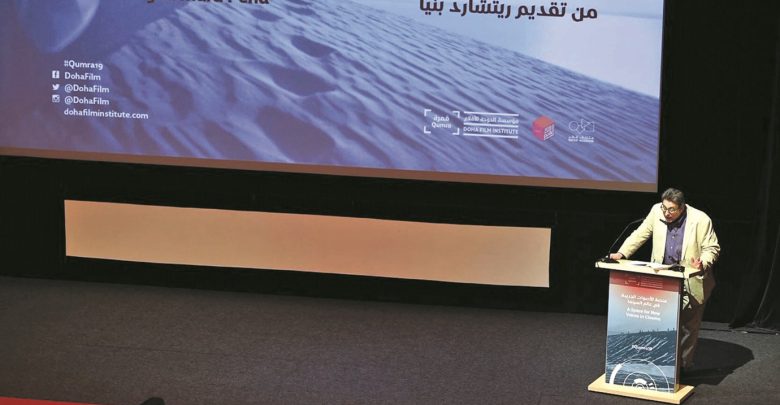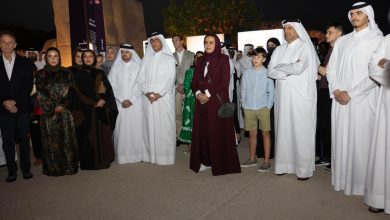
Agnès Varda’s guiding principles for filmmaking explained at Qumra
حلقة نقاشية حول قواعد أنييس فاردا في ملتقى قمرة السينمائي
Inspiration, creation, sharing. These are the three words that guide Agnès Varda every time she makes a film.
In a masterclass of the Qumra Master’s body of work presented by Richard Peña, first- and second-time filmmakers learned more about Varda’s hybrid approach to filmmaking at Qumra 2019.
Peña provided an analysis of clips from five of her films: La Pointe Courte (1955), Cleo from 5 to 7 (1962), Vagabond (1985), The Gleaners & I (2000), and The Beaches of Agnès (2008).
Richard Peña, an internationally renowned expert on film, was Professor of Film Studies at Columbia University and Director of the New York Film Festival from 1988 to 2012. He is a familiar face at Qumra, having contributed to previous editions in guiding up-and-coming filmmakers from around the world.
Varda, the ‘grandmother of French New Wave cinema’ is renowned for her unique short films, feature narratives and documentaries, and her unique artistic skill in combining all three formats in each of her projects.
He said of her work: “Agnès Varda is unique among her contemporaries for the seamless way in which her work flows between documentaries, shorts and feature length films. She pioneered the convergence of genres and formats into what we now call ‘research cinema’. Agnès was interested in very personal self-expression first and foremost, more than just entertainment.”
In the masterclass, Peña demonstrated how Varda revolutionised techniques such as discontinuity between shots, handheld camera work, low lighting, and later embraced innovative digital camerawork and mixed media shots.
On the topic of Varda’s place within French New Wave cinema, Peña said: “The problem with French New Wave is that it is very difficult to define. Is it a group of directors, a period, or a style of filmmaking? Within the French New Wave movement there was a difference between Right Bank and Left Bank groups of directors, towards which Agnès leaned to the Left, seeing cinema akin to art, literature and music. She was also influenced by the French feminist movement, although she resisted defining herself through political orthodoxies.”
Varda is much celebrated as a cinematic icon and is often a significant influence on some of today’s most acclaimed filmmakers. Among the substantial recognition for her work is a Silver Bear Prize at Berlinale for Cleo from 5 to 7 (1965); Golden Lion at the Venice International Film Festival for Vagabond (1985); Léopardo d’Onore at the Locarno Film Festival in 2014; Palme d’Or d’Honneur at Festival de Cannes in 2015; Grolsch Audience Award for Best Documentary at Toronto Film Festival for Faces Places (2017); and an Academy Honorary Award for her contribution to cinema. In 2003, she launched a third career as a visual artist, with her installations being exhibited at the world’s most prominent galleries and museums.
“Through her films and her lifetime curiosity about self-consciousness, Agnès is ultimately telling us about herself,” said Peña. “The powerful disarming honesty of her films is what makes us trust her as a filmmaker.”
The fifth edition of Qumra brings together more than 150 acclaimed filmmakers, industry professionals and experts to nurture 36 Qumra Projects by first and second-time filmmakers that are in various stages of development. The six-day event takes place 15–20 March at Souq Waqif and the Museum of Islamic Art, and features Qumra Masterclasses, Qumra Talks and screenings in the Qumra Masters and New Voices in Cinema series.
الإلهام والإبداع والمشاركة المبادئ الثلاثة التي ترشد أنييس فاردا في كل فيلم تصنعه، لتعلّم صناع الأفلام الذين يخوضون تجاربهم الأولى أو الثانية في الإخراج خلال ندوة دراسية ألقاها ريتشارد بنيا عن طريقة فاردا الهجينة في صنع الأفلام، إذ قدم بنيا تحليلاً لمقاطع من خمسة من أفلامها: لابورتي كورتي (1955)، وكليو من 5 إلى 7 (1962)، والمتشرد (1985)، والملتقطون وأنا (2000)، وشواطئ أنييس (2008).
تشتهر «جدة موجة السينما الفرنسية الجديدة» بأفلامها القصيرة الفريدة من نوعها، والأفلام الروائية والأفلام الوثائقية، ومهاراتها الفنية المميزة في الجمع بين الأشكال الثلاثة في كل مشروع من مشاريعها.
وقال بنيا -أستاذ في دراسات الأفلام بجامعة كولومبيا ومدير مهرجان نيويورك السينمائي من 1988 إلى 2012- عن أعمالها: «تعد أنييس فاردا فريدة من نوعها بين معاصريها، بسبب الطريقة السلسة التي يتدفق بها عملها بين الأفلام الوثائقية والأفلام القصيرة والأفلام الطويلة. كانت رائدة في تقارب الأساليب والأشكال فيما نسميه الآن «بالسينما البحثية»، واهتمت أنييس بالتعبير عن الذات شخصياً قبل كل شيء، أكثر من مجرد الترفيه».
وتحدث بنيا خلال ندوة قمرة الدراسية عن استخدام فاردا للتقنيات الثورية المختلفة، مثل التوقف بين اللقطات، والتصرف في الكاميرا، والإضاءة المنخفضة، واستعمال التصوير الرقمي المبتكر، ولقطات الوسائط المختلطة عند تطور التكنولوجيا.



